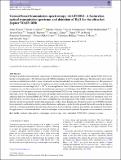Ground-based transmission spectroscopy with FORS2 : a featureless optical transmission spectrum and detection of H2O for the ultra-hot Jupiter WASP-103b
Abstract
We report ground-based transmission spectroscopy of the highly irradiated and ultra-short period hot-Jupiter WASP-103b covering the wavelength range ≈400–600 nm using the FORS2 instrument on the Very Large Telescope. The light curves show significant time-correlated noise which is mainly invariant in wavelength and which we model using a Gaussian process. The precision of our transmission spectrum is improved by applying a common-mode correction derived from the white light curve, reaching typical uncertainties in transit depth of ≈2 × 10−4 in wavelength bins of 15 nm. After correction for flux contamination from a blended companion star, our observations reveal a featureless spectrum across the full range of the FORS2 observations and we are unable to confirm the Na absorption previously inferred using Gemini/GMOS or the strong Rayleigh scattering observed using broad-band light curves. We performed a Bayesian atmospheric retrieval on the full optical-infrared transmission spectrum using the additional data from Gemini/GMOS, HST/WFC3, and Spitzer observations and recover evidence for H2O absorption at the 4.0 σ level. However, our observations are not able to completely rule out the presence of Na, which is found at 2.0 σ in our retrievals. This may in part be explained by patchy/inhomogeneous clouds or hazes damping any absorption features in our FORS2 spectrum, but an inherently small scale height also makes this feature challenging to probe from the ground. Our results none the less demonstrate the continuing potential of ground-based observations for investigating exoplanet atmospheres and emphasize the need for the application of consistent and robust statistical techniques to low-resolution spectra in the presence of instrumental systematics.
Citation
Wilson , J , Gibson , N P , Nikolov , N , Constantinou , S , Madhusudhan , N , Goyal , J , Barstow , J K , Carter , A L , de Mooij , E J W , Drummond , B , Mikal-Evans , T , Helling , C , Mayne , N J & Sing , D K 2020 , ' Ground-based transmission spectroscopy with FORS2 : a featureless optical transmission spectrum and detection of H 2 O for the ultra-hot Jupiter WASP-103b ' , Monthly Notices of the Royal Astronomical Society , vol. 497 , no. 4 , pp. 5155-5170 . https://doi.org/10.1093/mnras/staa2307
Publication
Monthly Notices of the Royal Astronomical Society
Status
Peer reviewed
ISSN
0035-8711Type
Journal article
Rights
Copyright © 2020 The Author(s) Published by Oxford University Press on behalf of the Royal Astronomical Society. This work has been made available online in accordance with publisher policies or with permission. Permission for further reuse of this content should be sought from the publisher or the rights holder. This is the final published version of the work, which was originally published at https://doi.org/10.1093/mnras/staa2307.
Description
JW would like to acknowledge funding from the Northern Ireland Department for the Economy. NPG gratefully acknowledges support from Science Foundation Ireland and the Royal Society in the form of a University Research Fellowship. ALC is funded by a Science and Technology Facilities Council studentship.Collections
Items in the St Andrews Research Repository are protected by copyright, with all rights reserved, unless otherwise indicated.

